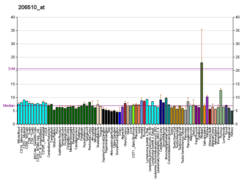SIX2
In this article, we are going to delve into the topic of SIX2, which has captured the attention of academics, experts and the general public due to its relevance today. From its origins to its implications in different areas, SIX2 has been the subject of debate and study, generating different types of opinions and perspectives that enrich the current panorama. Through a detailed analysis, we aim to provide the reader with a broad and complete vision of SIX2, addressing its most relevant aspects in order to shed light on this topic of great interest.
Homeobox protein SIX2 is a protein that in humans is encoded by the SIX2 gene.[5][6]
References
- ^ a b c GRCh38: Ensembl release 89: ENSG00000170577 – Ensembl, May 2017
- ^ a b c GRCm38: Ensembl release 89: ENSMUSG00000024134 – Ensembl, May 2017
- ^ "Human PubMed Reference:". National Center for Biotechnology Information, U.S. National Library of Medicine.
- ^ "Mouse PubMed Reference:". National Center for Biotechnology Information, U.S. National Library of Medicine.
- ^ "Entrez Gene: SIX2 sine oculis homeobox homolog 2 (Drosophila)".
- ^ Oliver, Guillermo (1995). "Homeobox genes and connective tissue patterning" (PDF). Development. 121 (3): 693–705. doi:10.1242/dev.121.3.693. hdl:11858/00-001M-0000-0013-037D-E. PMID 7720577.
Further reading
- Strausberg RL, Feingold EA, Grouse LH, et al. (2003). "Generation and initial analysis of more than 15,000 full-length human and mouse cDNA sequences". Proc. Natl. Acad. Sci. U.S.A. 99 (26): 16899–903. Bibcode:2002PNAS...9916899M. doi:10.1073/pnas.242603899. PMC 139241. PMID 12477932.
- López-Ríos J, Tessmar K, Loosli F, et al. (2003). "Six3 and Six6 activity is modulated by members of the groucho family". Development. 130 (1): 185–95. doi:10.1242/dev.00185. PMID 12441302.
- Ikeda K, Watanabe Y, Ohto H, Kawakami K (2002). "Molecular interaction and synergistic activation of a promoter by Six, Eya, and Dach proteins mediated through CREB binding protein". Mol. Cell. Biol. 22 (19): 6759–66. doi:10.1128/MCB.22.19.6759-6766.2002. PMC 134036. PMID 12215533.
- Buller C, Xu X, Marquis V, et al. (2002). "Molecular effects of Eya1 domain mutations causing organ defects in BOR syndrome". Hum. Mol. Genet. 10 (24): 2775–81. doi:10.1093/hmg/10.24.2775. PMID 11734542.
- Boucher CA, Winchester CL, Hamilton GM, et al. (2000). "Structure, mapping and expression of the human gene encoding the homeodomain protein, SIX2". Gene. 247 (1–2): 145–51. doi:10.1016/S0378-1119(00)00105-0. PMID 10773454.
- Celli J, van Beusekom E, Hennekam RC, et al. (2000). "Familial syndromic esophageal atresia maps to 2p23-p24". Am. J. Hum. Genet. 66 (2): 436–44. doi:10.1086/302779. PMC 1288096. PMID 10677303.
- Kawakami K, Ohto H, Takizawa T, Saito T (1996). "Identification and expression of six family genes in mouse retina". FEBS Lett. 393 (2–3): 259–63. Bibcode:1996FEBSL.393..259K. doi:10.1016/0014-5793(96)00899-X. PMID 8814301. S2CID 20829948.





